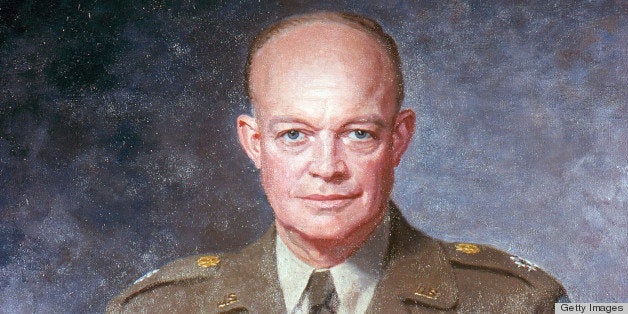
The American "pervert" was defined, codified and banned from public service by an executive order signed by President Dwight Eisenhower, effective 60 years ago this month (May 27).
The American pervert was a "criminal, infamous, dishonest" being. Worse, he or she was "immoral or notoriously disgraceful," incapable of "unswerving loyalty to the United States." Conjured from Cold War politics, the perfervid mind of FBI director J. Edgar Hoover and Justice Department attorneys, Executive Order 10450 authorized personal investigations by the FBI and Civil Service Commission for "sexual perversion" in all branches of the federal government. According to the White House press release, in the first four months, 1,456 employees had been "separated from Federal service ... for security reasons only." Some 800 homosexuals were fired or had resigned by 1955, according to David Johnson, author of The Lavender Scare. Untold thousands more were hounded and banned from public service for decades to come.
The historic animus of the federal government toward homosexuals, now a factor in U.S. Supreme Court deliberations on same-sex marriage, does not begin with "millennia of moral teaching," as Chief Justice Warren Burger premised in his opinion in the 1986 case Bowers v. Hardwick, upholding anti-gay sodomy laws. Rather, it was locked into the law with this 1953 executive order.
Most Americans have not heard of this executive order. The three most recent Eisenhower biographies give it exactly no mention. These are sophisticated and nuanced books by Jean Edward Smith (Eisenhower: In War and Peace, Random House, 2012), Jim Newton (Eisenhower, The White House Years, Doubleday, 2011) and Evan Thomas (Ike's Bluff, Little, Brown, 2012). The executive order that invented the disgraceful "pervert" is not referenced once in these books. D.C. insider journalist Evan Thomas' biography focuses on the president's canny foreign policy strategy while ignoring the State Department purges of homosexuals. The autobiography of Eisenhower's attorney general, Herbert Brownell, Advising Ike, published more than 20 years after the Stonewall riots, does not mention the executive order. If one accepts these histories as a contemporary mainstream consensus, the "Lavender Scare" is but a footnote to McCarthyism, or it never happened.
To better understand this complete deletion of gay political history, last year I visited the Dwight D. Eisenhower Presidential Library and Museum in Abilene, Kan. Here are the documents and the exhibits, under the management of the National Archives and Records Administration (NARA), that tell the story of the Eisenhower presidency. With the able assistance of the library research staff, I was able to uncover the true story of Eisenhower political advisor and family friend Arthur Vandenberg Jr., a human face for the injustice of the time.
Vandenberg helped organize "Citizens for Eisenhower," the national grassroots effort to promote candidate Ike as a Republican. He wrapped Gen. Eisenhower in the mantle of his own revered father, Senate Foreign Relations Committee chairman Arthur Vandenberg Sr., to help win a bruising fight for the Republican nomination. After the election Eisenhower chief of staff Sherman Adams announced Vandenberg's appointment as Secretary to the President. But this was not to be: The president-elect fired him just before the inauguration. J. Edgar Hoover had given Eisenhower his report: Vandenberg was homosexual. In a Jan. 5, 1953, memorandum, Hoover wrote, "I told the General that Vandenberg had asked that we not interview the young man at present living with Vandenberg." The president wrote to Vandenberg in a Jan. 17 letter, "I am very distressed about your health ... I realize that you have been in this thing from the very beginning ... On that account I feel in some respects guilty. ... Meanwhile, as I know you understand, we have to go ahead with the setup." Vandenberg's "health" was the cover story.
Three months later President Eisenhower signed the executive order that could provide an additional benefit: more cover if it were ever discovered that a homosexual, by definition a security risk, had become part of Gen. Eisenhower's inner circle. This was a presidential conflict with friendship and loyalty, the personal kind.
The Eisenhower Museum's version of events appears on a bright-red text board under the heading "Personal Freedom vs. National Security." It reads, "Eisenhower believed that personal initiative and freedom lay at the heart of the American way of life." Later it continues, "Eisenhower recognized that internal threats to American national security existed. ... Investigators reviewed thousands of government workers deemed possible security risks, and dismissed around 1,500 between 1953 and 1957. Another 6,000 resigned rather than undergo often far-reaching questioning of their personal lives."
I had found my answer. The Eisenhower Museum interprets the executive order by not mentioning the word "perversion." The visitor must decode the phrase "questioning their personal lives." LGBT Americans remain the invisible human wreckage. Newly declassified documents reveal that the "questioning" was a systematic, sometimes obsessive investigation, managed by Hoover himself, as part of the FBI's "Sex Deviates in Government Service" program.
Hoover appointed a "Sex Deviates" contact in each of the branches of government. It was these individuals' responsibility to identify or contact the deviates for investigation. Covering the United States courts, Hoover's contact was one Elmore Whitehurst. In September 1953 Hoover wrote Whitehurst, "[A]n employee of the U.S. Court of Claims ... admitted that he was a homosexual." Hoover had been contacted by the employee's attorney and was furious at the breach of confidentiality. Elmore Whitehurst, with an office in the U.S. Supreme Court building, was duly upbraided.
Beyond contacts like Whitehurst, and above the "Sex Deviates" program itself, stood the Department of Justice. Eisenhower Library staff helped us discover an April 10, 1953, White House memorandum from presidential advisor Bernard Shanley to chief of staff Sherman Adams: "Assistant Attorney General Warren Burger will have the responsibility of defending any action under the security order ... He is aware that this will also include the regulations." Warren Burger, hardly in "millennia" past but in 1953, took on his first D.C. assignment, at age 46, vigorously defending the executive order. Three years later Burger was appointed to the U.S. Court of Appeals for the District of Columbia, one day to become the chief justice of the Supreme Court.
There is no remedy for the thousands whose lives were destroyed, the searing and humiliating personal investigations, the untold numbers of men and women driven from public service. But, as in any "truth and reconciliation" project, let us at least tell the story. The National Archives and Records Administration working with the curators at the Eisenhower Presidential Library and Museum should take down that text board for review and a rewrite. Add the words "sexual perversion." Following the word "thousands" insert "homosexuals." Then add "LGBT Americans."
